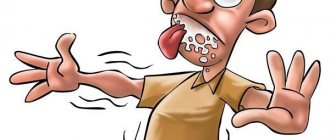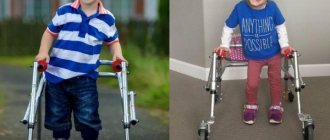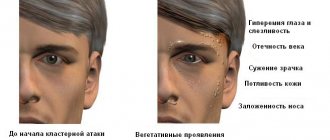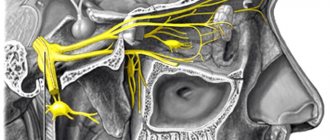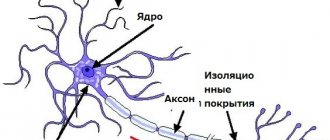Acalculia is a general concept that includes disorders that cause a person to have difficulty understanding numbers and performing various mathematical operations. With this pathology, there is no visual and auditory recognition of numbers, and there is also no understanding of mathematical operations, perception of the number series and the ability to consistently perform mathematical operations.
The diagnosis is made based on the results of an examination, which includes neurological and psychiatric examinations, as well as consultations with an ENT doctor and an ophthalmologist. An arithmetic test is mandatory for the patient.
Acalculia - what kind of disease is this?
- 1. General characteristics of the violation 1.1. Description
- 1.2.Acalculia and dyscalculia: differences
- 4.1.Signs
- 5.1. Treatment, correction
- Dementia - what is this disease?
- Very simple about the subconscious
- Schizoid and Schizoid: Signs and Causes
- Paraphrenic syndrome in schizophrenia. Clinical picture
- Psychologist - what kind of specialist is this? Let's find out more
Origin of the disease
The development of pathology is caused by:
- Fear of arithmetic - the violation is based on the negative experience of learning to count through coercion and punishment. This unusual phobia is due to the fact that when solving arithmetic examples, especially problems, the child had difficulties or was often scolded and punished. Over time, he developed fear and self-doubt for fear of being punished.
- Social problems. They most often occur in children who are brought up in conditions of pedagogical neglect, in a dysfunctional family.
- Damage to the parietal lobe of the cerebral cortex due to the pathology of pregnancy and childbirth, brain injuries and neuroinfections, tumors and genetically determined defects.
Dyscalculia in children often occurs due to disorders of mental activity. These include:
- disturbance in the processing of visual information;
- decreased concentration;
- violation of logical thinking;
- problems with assimilation and memorization of information.
Dyscalculia can be combined with reading and writing disorders such as dysgraphia and dyslexia, as well as ADHD (attention deficit hyperactivity disorder).
Acalculia, as a rule, is a symptom of a mental illness, but sometimes acts as an independent pathology. Based on the main cause, the disease is divided into primary and secondary forms. Primary acalculia occurs due to damage to the parietal, occipital or temporal lobe of the left hemisphere of the cerebral cortex.
Secondary acalculia is included in the structure of the neuropsychological syndrome. This means that it can form with a general impaired development of intelligence and against the background of other mental disorders. This form of the disease develops when the temporal or occipital lobe of the cerebral cortex, as well as its prefrontal parts, is involved in the pathological process as a result of injuries or organic pathologies.
Acalculia is an acquired disease that develops due to damage to certain areas of the brain. The cause may be injury or the development of tumors. Very often, acalculia develops against the background of a mental disorder.
The brain damage in which the disease develops is concentrated in the parietal, occipital and temporal cortex of the brain. The causes of such lesions may be:
- Heredity.
- Various neurological disorders during the perinatal period.
- Tumors in the brain.
- Intoxication of varying degrees of intensity.
- Brain damage due to the development of infectious diseases.
- Negative impact of the social environment.
- Traumatic brain injuries.
- Cerebrovascular diseases.
As a rule, this is a symptom of some mental illness, but acalculia can also act as an independent pathology.
At school age, about 5 percent of children suffer from dyscalculia. This is a misunderstanding of the principle of counting, the inability to distinguish between arithmetic operations. Acalculia and dyscalculia are interrelated diseases.
We are talking about acalculia if the child was mentally developed, but lost his ability as a result of injury or disease. With dyscalculia, the child loses the ability to learn any arithmetic operation, and often this is combined with the problem of the inability to recognize letters.
Dyscalculia in children begins to develop from an early age. It is expressed in the fact that it is simply impossible to teach such a child any arithmetic operations. His brain completely refuses to perceive this information. Most often, this disease occurs in children with a genetic predisposition. As a result, the disease develops into mental retardation.
Types of disease
Depending on the manifestation, there are many types of acalculia.
Verbal
Characterized by difficulties in denoting mathematical terms, concepts and operations verbally. It is quite possible that the patient is fluent in arithmetic, but cannot express it.
Apraxic
A person is not able to independently determine the number of objects that are nearby.
Dyslexic
It manifests itself in the fact that the patient suffers defeats in attempts to read some arithmetic sign or symbol. It is believed that this type of disorder can be transmitted at the genetic level.
Graphic
In this case, the name speaks for itself; graphic acalculia deprives a person of the ability to display mathematical operations in writing. Such a person will not even be able to draw a basic geometric figure.
operating room
During the operational type of disorder, it will be almost impossible for the patient to perform arithmetic operations: add, subtract, divide and multiply. Perhaps this will manifest itself partially. For example, a person copes well with subtracting numbers, but cannot multiply them.
Primary
Scientists believe that the disease of primary acalculia has no connection with disorders of other mental functions. It appears due to damage to the left hemisphere of different areas of the cerebral cortex: frontal or parietal.
Frontal
Impaired functioning of the frontal lobes of the brain leads to loss of conscious activity in a person. Thus, the individual cannot perform precise mathematical operations.
Parietal
Occurs as a loss of spatial thinking. Accordingly, the patient cannot understand the concept of “numbers” and everything connected with them.
Secondary
It is part of a neuropsychiatric syndrome that already exists in the individual. It appears as a result of a lack of ability for purposeful mental functions. Secondary acalculia has several subspecies.
Optical
A variety that appears due to problems with vision receptors. The patient literally cannot distinguish one number from another.
How common is dyscalculia?
According to various sources, approximately 5-6 percent of primary school students have difficulty with counting operations. These statistics cannot claim complete objectivity, since the diagnosis of dyscalculia is made only in some cases. In most situations, parents are not inclined to associate the fact that a child does not count well with any deviation. As a rule, such a child is defined as a “humanist” and concentrated on his abilities in other sciences.
Psychologists advise paying attention to the first signs of dyscalculia when a child is 5-6 years old. It is during this age period that the child begins to actively learn and become familiar with numerical symbols and the actions performed with them.
- Graphic dyscalculia. A person has difficulty writing numbers and other symbols. In the same case, difficulties in perceiving geometric shapes are observed.
- Practognostic. Abstract mathematical concepts cannot be translated into real-life examples. As a result, the perception of arithmetic calculations deteriorates and the person experiences difficulties in applying them in practice.
- Lexical. The child can absorb information about rules and numbers from teachers or parents, but cannot study independently because he cannot comprehend mathematical signs through reading.
- Verbal. Numbers and mathematical concepts are not perceived or are not well understood by ear. At the same time, the ability to complete written tasks is preserved.
Certain types of dyscalculia can be combined with each other, making diagnosis and subsequent treatment difficult.
Aspects of the syndrome
For the first time, information about such a disease as acalculia appeared in 1919. Based on the results of the research, the pathology was divided into primary and secondary. The primary form develops with damage to the temporal, parietal and occipital parts of the cerebral cortex. With this development, the patient’s ability to analyze and synthesize spatial representations is impaired.
The patient cannot distinguish the numbers or perform any actions with them. Doctors have established the fact that the difficulty arises due to a person’s lack of understanding of “left, right, up, down.”
These disorders are most difficult in children. The child may not develop an understanding of space by the time he starts school. This will lead to the inability to master arithmetic numbers.
Symptoms of primary acalculia are:
- No difference between numbers. For example, the patient does not understand the difference between 545 and 455.
- Inability to differentiate between digits of numbers.
- Complete lack of concept of number.
- Misunderstanding of spatial coordinates.
- Difficulty performing any type of arithmetic operations.
Links[ | ]
To improve this article it is desirable:
Please, after fixing the problem, remove it from the list of parameters. After eliminating all the shortcomings, this template can be deleted by any participant. |
| This is a draft article on neurology. You can help the project by adding to it. |
Why does dyscalculia occur?
There are three causes:
- Psychogenic
- Organic
- Genetic
In some cases, several reasons may be combined. Parents should remember that without clearly identifying the signs and causes of dyscalculia, it is almost impossible to select competent measures to eliminate the disease.
Psychogenic disorders are characterized by a child’s negative or completely negative attitude towards arithmetic operations. With what it can be connected? For example, with pressure from parents and teachers in the process of learning the basics. Physical punishment for bad grades, conflicts between teacher and child can also be attributed to psychogenic reasons.
Genetic causes of dyscalculia are found in primary schoolchildren and preschoolers, whose parents had similar difficulties with arithmetic operations. Unfortunately, scientists have not yet been able to find the gene that is responsible for the abilities of addition, subtraction, multiplication and division. But a number of specialists are increasingly talking about the genetic nature of this disorder and are conducting active research in this direction.

Organic causes of dyscalculia are associated with certain disturbances in the structure and functioning of certain areas of the brain. In this case, we are talking about the areas of the brain that are responsible for the ability to perceive and analyze received information. How can such causes of dyscalculia occur?
What complications can the syndrome cause?
The manifestation of acalculia syndrome significantly inhibits personality development. She becomes poorly trained, because she perceives the material worse. A specialist with this syndrome quickly loses his qualifications. In addition, having such a disease, many feel inferior. This is where mental disorders appear.
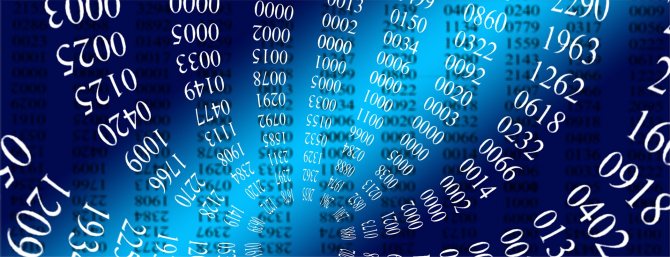
Like any disorder caused by abnormalities in the structure of the brain, acalculia is very dangerous, but do not despair. In the vast majority of cases, complete rehabilitation of the patient is possible.
Video for the material
If you see an error, please select a piece of text and press Ctrl+Enter.
Test tasks for diagnostics
Parents can see dyscalculia in children themselves; if pathology manifests itself, they should immediately consult a doctor. The specific type of disease is determined after consultation with a speech therapist, neurologist, or psychologist.
When a child talks with doctors, he is asked to count, perform a simple arithmetic operation, and arrange cards with numbers in decreasing or increasing order. Depending on the violations identified during the execution of tasks, the type of disease will be determined.
The types of dyscalculia are as follows:
- Graphic – the child cannot write down numbers and mathematical symbols. He has difficulty depicting geometric shapes.
- Verbal - the patient experiences difficulty when asked to name an arithmetic operation.
- Dyslexic - this form of the disease manifests itself in the inability to read mathematical symbols.
- Operational – the inability to perform an arithmetic operation.
Establishing the type of pathology allows for the most effective correction of dyscalculia.
You can suspect dyscalculia in a child even before school starts. It is enough to ask a 5-7 year old child to count something, after which you can see that performing basic mathematical operations causes him significant difficulties.
Test tasks for children of primary school age:
- count from 10 to 20 (counting up to 10 can be perfect);
- arrange numbers in ascending and descending order;
- compare two numbers;
- determine the name of geometric shapes, classify them by color, size;
- perform arithmetic operations (addition and subtraction);
- analyze the human body diagram;
- determine the direction left and right.
After the examination, the specialist can accurately determine the form of dyscalculia and begin work on its correction.
Symptoms of acalculia
Clinical manifestations vary depending on the form of pathology. Primary acalculia is characterized by a lack of understanding of the concept of number, numerical digits (for example, patients do not see the difference between the numbers 152 and 125), the inability to compare numbers, or carry out simple arithmetic calculations. It is combined with spatial agnosia that occurs when the parietal region is damaged, manifested by a violation of the “right-left”, “top-bottom” orientation, perception of the coordinate system, etc.
Secondary acalculia is detected in combination with other cognitive disorders: agnosia, apraxia, aphasia, amnesia. The optical form is manifested by the absence or errors in recognition of the depicted numbers. Patients cannot name the number they see and confuse numbers that are similar in design (7 and 1, 9 and 6). The concept of number, auditory perception of numbers, and the ability to perform counting operations in the mind are preserved. Typical symptoms of visual agnosia are failure to recognize letters, faces, or images of objects. Dysgraphia and dyslexia are noted.
Dyscalculia and the brain

Regardless of the cause of this disorder, a person suffering from dyscalculia experiences neural dysfunction in the parietal cortex of the cerebral hemispheres. Disturbances are clearly observed in the area of the intraparietal sulcus. This is where the center is located, which is responsible for the perception of symbols and the ability to count.
If a child is diagnosed with dyscalculia, then most often you will find that at the same time, he also has a reduced ability to cognition and analyze the information received. As a rule, this can be explained by insufficient processing speed of incoming data and insufficient concentration.
Treatment and prevention
Acalculia is treatable, but to completely eliminate the symptoms, it is necessary to eliminate the cause of the pathology, the disease that caused the disorders. A different situation arises with dyscalculia. Since this disease is not acquired, but congenital, treatment involves only correction and preventive measures.
Treatment methods for acalculia will depend on the patient's age and the severity of the disease. If an adult is sick, therapy will be carried out with specialists using various computer programs. The patient is gradually brought to awareness of the concept of number. After this, learning mathematical operations begins, from simple to more complex.
For children, treatment is based on play. Most often, pictures with numbers are used for this. The child is visually taught to distinguish numbers.
Correction of dyscalculia should be carried out by a speech therapist. If necessary, a psychologist and a neurologist can be involved in working with the patient. Special techniques are being developed for correction. Classes can take place in any place comfortable for the child. The technique consists of a whole set of game exercises that teach counting. Also, classes should be aimed at developing the child’s speech, thinking, and visual abilities.
To eliminate dyscalculia, it is very important to develop competent and coherent speech. Correction should be based on expanding the child’s vocabulary while simultaneously learning mathematical terms. at the very beginning, an understanding of more, less, the name of geometric figures, and the characteristics of an object should be introduced.
The next stage introduces teaching ordinal counting and the use of numbers in speech. The child is taught to compare numbers, objects, their quantity, and quality characteristics. The child forms a connection between a number and its visual expression in writing. Both fine motor skills and thinking develop immediately.
As soon as stable achievements in counting are achieved, the teacher moves on to simple arithmetic operations. The goal is to show the child the logic of the solution.
Acalculia requires therapy based on eliminating the underlying cause. The form of the syndrome directly affects how computational abilities are restored. Responsibility for this lies with clinical psychologists, speech pathologists, neuropsychologists and psychiatrists.
In this case, the key goal is to restore understanding of numbers and their place value structure. Among the most effective methods are the following:
- method of understanding digits;
- method of working with numbers;
- visual method.
Special techniques based on visual memory are usually used in severe forms of the disease. These can be cards laid out in a row in front of the patient with the image of the number of objects and the corresponding numbers.
The game form in the case of children brings a more tangible effect. For example, under the number 4 there will be 4 books on the card.
The color scheme of objects should be bright and varied, since color plays an important role in the process of memorization and perception.
The essence of the method of working with numbers is the need for the patient to break any number into the maximum possible variations. Sticks are great for this exercise. For example, the patient is asked to break the number 7 into possible variations.
All completed actions must be recorded in a diary. Over time, the sticks can be disposed of and replaced with verbal commentary on the arithmetic operation if the patient makes progress. All counting operations will need to be spoken out loud, then you can switch to a whisper, and as a result, the person learns to count in his head.
If the inability to analyze the digits of numbers is accompanied by a violation of their names, it is important to pronounce all numbers up to 100, and the work of the speech pathologist will be to identify the difference between ones and tens.
An equally effective exercise is when the patient needs to write the name of the number under its name. For example, under the inscription three hundred and forty-seven, the patient should write 347.
Only the first 2-3 lessons are conducted in a visual-figurative style, after which a gradual transition to vocal voicing of processes is relevant. In adults, mild stage acalculia is corrected more effectively than in children.
In the secondary form, the location of the brain lesion directly affects the nature of the recovery of numerical concepts and counting.
- Occipital lesions require correction of correct spelling and visual perception. The most effective techniques are exercises with motor imagery of numbers, manipulation with problems and numbers, and subject counting. The method of voicing is no less effective, when the patient imagines a number in his mind. The result is possible with well-developed visual memory, imagination, and also with intact auditory perception.
- Problems with auditory perception of numbers are typical when the temporal zones are affected. Specialized therapeutic restoration in this case is not relevant, since the violation is insignificant.
- Prefrontal lesions require patients to be taught a simple understanding of numbers; arithmetic operations are gradually introduced, where numbers act as objects. At the final stage, the defectologist introduces arithmetic operations with sequential actions.

The patient will analyze arithmetic operations both through an objective digit understanding of numbers and through habitual object characteristics, if manipulation of objects is introduced along with numbers.
One can move from the primary subject assessment to a digit, spatial characteristic by switching to the internal program of consciousness from external actions. Gradually, arithmetic manipulations are restored, as is their understanding.
Acalculia can be treated, but to completely eliminate the syndrome, it is necessary, first of all, to treat the underlying disease. In the primary form of the disorder, the need to renew the concept of numbers and their ranks comes to the fore. To restore such patients, modern medical practice successfully uses the visual method, as well as the method of working with numbers and understanding their digits.
There are specialized techniques, the use of which can help in the most severe cases. They are based on human visual memory. The training can take place in this way: cards with images of numbers and objects of similar quantities are laid out in front of the patient. This method can be used for both adults and children in a playful way.
Secondary acalculia is somewhat more difficult to treat. The patient’s ability to recover depends, first of all, on the location of the lesion in the brain. Correction can be aimed at visual features of numbers, teaching simple understanding of numbers, performing mental calculations and arithmetic operations, etc.
In clinical practice, the method of manipulating objects and numbers is actively used. This allows patients to independently analyze mathematical operations with an objective digit understanding of numbers.
As for the prevention of acalculia, it should consist of preventing traumatic brain injuries and vascular diseases of the brain. Any pathology requires timely diagnosis and treatment, especially for tumor growths in the cerebral cortex.
Prevention methods
Preventive measures for the disorder will depend on what type of pathology the patient has:
- Graphic – prevention of this type of disorder is possible with the help of exercises for the development of visual images, fine motor skills, coordination between hand movements and vision.
- Verbal disorder can be prevented by teaching the child the names of mathematical operations and their essence. Children must be able to use concepts correctly in their speech. All memory functions develop, the child acquires an understanding of shape, color and size.
- The practical-gnostic type is prevented by teaching counting skills in mathematics; arithmetic operations must be performed with their sequential pronunciation. It is important that the result is spoken out loud. Visual perception, coordination of movement, and the ability to correlate a real object and its image must develop.
- The dyslexic variant is prevented by the development of visual perception in the child. He must have an idea of shape, color, correctly recognize and name mathematical symbols, understand the meaning of signs, develop memory and logical thinking.
All preventive measures are aimed at developing a stable perception of visual mathematical symbols, and then their competent use in arithmetic calculations.
Timely detection of a problem will help eradicate it at the very beginning and improve the child’s performance at school.
Precautionary measures to prevent dyscalculia can be carried out in early preschool childhood. First of all, the most complete correction of existing neurological pathologies should be carried out. At an early age, you can start learning basic mathematics in a playful way.
Parents should clearly demonstrate to their child how to count objects, shapes and perform basic mathematical tasks, for example, while swimming, you can ask your child to count blue balls or catch three red balls with a net. When teaching a child to count, it is necessary to carefully pronounce the names of numbers, and then arithmetic operations.
To prevent a child from developing operational dyscalculia, he must be taught the rules of counting and the order of mathematical operations. To prevent verbal and lexical problems, it is necessary to ask the child to say the name of the numbers when counting, and when looking at various figures and other objects - their color and shape.
To prevent the occurrence of dyscalculia in graphic form, it is necessary to pay special attention to the development of the child’s visual memory, fine motor skills, coordination of movements through finger and outdoor games, collecting cut pictures, cubes, puzzles, playing with small parts of the construction set, stringing beads on a cord, identifying them shape and color. The productive activities of children are very effective in this regard - modeling, drawing, appliqué, making crafts, origami.
Moms and dads must pay attention to the development of thinking and memory in the child, and then, in the future, the occurrence of dyscalculia can be avoided.
How to diagnose the symptoms of dyscalculia?
Each deviation has its own characteristics. If you notice one of the signs described above in your child, try contacting a speech therapist or psychologist. Only a specialist can see the signs of dyscalculia, conduct the necessary tests and establish the correct diagnosis. Making a diagnosis takes some time.
In addition to collecting an anamnesis, the specialist will definitely conduct several tests on the perception and application of abstract numbers in practice, study the person’s neurological functions, and assess a person’s abilities in mathematics. Sometimes a special technique is used to make a diagnosis: a person with suspected dyscalculia may undergo electroencephalography or MRI.
Children suffering from dyscalculia are not able to understand what a number is and on what principle the number series is built; they cannot distinguish and remember numbers. They cannot perform operations with numerical values and do not know how to decompose them into terms. It is difficult for them to compare the number of objects, perform simple arithmetic operations and carry out calculations according to the internal plan, that is, to count “in their minds”.
Symptoms of dyscalculia:
- difficulty recognizing and writing numbers;
- inability to tell time and navigate hours, minutes, seconds;
- impaired coordination of fine movements;
- inability to determine the distance traveled or measure the length of a segment;
- difficulty in perceiving the concepts “less” and “more”;
- the impossibility of solving problems without illustrative support;
- difficulties in solving logical problems and performing actions with abstract categories;
- inability to visually determine the number of objects, putting them into groups without counting them one by one.
It is in children that the primary form of the pathology in question manifests itself most clearly. By the time a young patient enters school, the parts of the brain responsible for understanding spatial phenomena may not have had time to develop. The result is a challenge in understanding arithmetic operations and the meaning of numbers in the first year. The following symptoms are also observed.
Manifestations of the primary form:
- the concept of more is less in relation to arithmetic operations is violated;
- the concept of numbers is missing;
- arithmetic operations are carried out problematically;
- the concept of spatial coordinates is violated;
- there is no difference in the bit structures of numbers;
- there is no understanding of the difference between numbers if the parietal region is affected;
- difficulties in evaluating arithmetic objects containing the number zero;
- figurative perception of a number in the form of an object, for example, 50 roses, 10 hryvnia;
- occasionally there remains the possibility of addition;
- serious problems in the process of subtraction, especially if you have to work with numbers separated by ten;
- Acalculia in this form is rarely combined with speech disorders.
If this pathology is the result of damage to the frontal part of the brain, the patient understands the principle of numerical digits and basic arithmetic calculations are available to him. More complex actions and manipulations cause serious difficulties.
Symptoms of the secondary form
The secondary form is caused by lesions in the prefrontal, temporal or occipital regions of the brain.
- Problems in the occipital region lead to impaired visual perception of numbers. The underlying disease may be optical agnosia or alexia. The patient may not be able to distinguish numbers that are similar in spelling visually; their place value understanding of numbers is retained. Often such problems are accompanied by amnesia for the names of numbers.
- A defect in auditory understanding of numbers is observed with damage to the temporal cortex. The main disease is sensory or acoustic-mnestic aphasia.
- Problems in the prefrontal area lead to impaired understanding of arithmetic operations. The dominant hemisphere is most often affected. For right-handers, it is the left hemisphere, and for left-handers, it is the right.
Types and forms of the disease
The development of acalculia occurs with disorders of various cognitive systems. Depending on which cognitive function is affected, the following types of disease are distinguished:
- Verbal – deviations in the verbal designation of mathematical concepts. The patient can successfully perform mathematical operations, but cannot verbally indicate the names of numbers, symbols, and is unable to indicate the number of objects.
- Apraxic – a person is unable to count objects. The patient cannot count objects and identify their quantitative characteristics.
- Dyslexic – lack of ability to read mathematical symbols and express quantitative terms.
- Graphic – the inability to write down mathematical symbols and signs, as well as to correctly depict geometric figures.
- Operational – loss of ability to perform mathematical operations.
Also, cases of acalculia can be divided on the basis of primary and secondary.
Primary (specific) – caused by lesions of areas of the cerebral cortex, the following types are distinguished:
- Frontal - caused by dysfunction of the frontal lobe of the brain, which is responsible for the control and regulation of all human mental functions. The ability to count is impaired due to deviations in the organization of conscious activity.
- Parietal (parieto-occipital) - occurs when the parieto-occipital areas of the brain are damaged. The patient’s concept of “number”, understanding of the essence of counting operations, and perception of spatial coordinates are impaired.
Secondary (nonspecific) – occurs due to a neuropsychiatric disease, the following types are distinguished:
- Optical - occurs with pathologies of the lobes of the brain responsible for the visual analyzer. With optical acalculia, the visual perception of numbers and mathematical symbols is impaired. The patient is unable to distinguish between similar arithmetic symbols and recognize Roman numerals.
- Sensory – develops with damage to areas of the brain involved in the acoustic perception of speech. Manifests itself in difficulties with oral counting and carrying out counting operations by ear.
- Acoustic-mnemonic – also associated with the acoustic perception of speech. The difference is that the patient has impaired auditory-verbal memory and a reduced volume of auditory perception.
How to treat dyscalculia?
The treatment regimen depends on the type of dyscalculia or a combination of both. Treatment may include special calculation exercises, orientation exercises in one’s own body and space, and memorization of poetry. In some cases, a neurologist or psychologist may prescribe antioxidants or nootropics. If you use an integrated approach to treatment and correctly follow all the specialist’s recommendations, then we can say with confidence that dyscalculia can be easily treated not only in children, but also in adults.
You can also improve your counting abilities with the help of special exercise machines. Addition, subtraction, multiplication and division - with regular practice, all these mathematical operations can be performed in your head.

